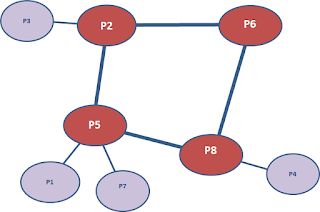Enquanto subia a A25, pensei no artigo e, recordando este postal “Mais uma sugestão de modelo de negócio” pensei que se tratava de uma movimentação da empresa Douro Azul, que veria os taxistas como “partners”.
Só ontem Domingo é que li o artigo e percebi que a Douro Azul não tem nada a ver com isto. No entanto, já tinha arquitectado um postal sobre o tema, que julgo, não perde a sua razão de ser.
Esta semana, no âmbito de um projecto, vou discutir com uma empresa as primeiras versões dos seus mapas da estratégia.
- Formularam uma estratégia, traduziram essa estratégia num mapa da estratégia. Contudo, a estratégia nunca está terminada. Mesmo que o mundo não mudasse, a estratégia deve ser sempre alvo de aperfeiçoamento e melhorias.
"In my metaphor, managers are craftsmen and strategy is their clay. Like the potter, they sit between a past of corporate capabilities and a future of market opportunities. And if they are truly craftsmen, they bring to their work an equally intimate knowledge of the materials at hand. That is the essence of crafting strategy.Acho super interessante como metáfora pensar na evolução de uma estratégia da mesma forma que um oleiro molda o barro nas suas mãos... ele parte de uma ideia deliberada, depois, com o trabalhar do barro, com o jogo entre as mãos e o material, enquanto a roda gira, vão surgindo ideias para concretizar ainda mais a intenção inicial.
...
One idea leads to another, until a new pattern forms. Action has driven thinking: a new strategy emerged.
...
My point is simple, deceptively simple: startegies can form as well as be formulated.
...
To manage strategy is to craft thought and action, control and learning, stability and change.
....
Craftsmen have to train themselves to see, to pick up things other people miss. 'The same holds true for managers of strategy It is those with a kind of peripheral vision who are best able to detect and take advantage of events as they unfold."
"No craftsman thinks some days and works others. The craftsman's mind is going constantly in tandem with her hands. Yet large organizations try to separate the work of minds and hands. In so doing, they often sever the vital feedback link between the two.
...
In practice, of course, all strategy making walks on two feet, one deliberate, the other emergent. For just as purely deliberate strategy making precludes learning, so purely emergent strategy making precludes control. Pushed to the limit, neither approach makes much sense. Learning must be coupled with control. ...
Likewise, there is no such thing as a purely deliberate strategy or a purely emergent one. No organization—not even the ones commanded by those ancient Greek generals— knows enough to work everything out in advance, to ignore learning en route. And no one - not even a solitary potter - can be flexible enough to leave everything to happenstance, to give up all control. Craft requires control just as it requires responsiveness to the material at hand. Thus deliberate and emergent strategy form the end points of a continuum along which the strategies that are crafted in the real world may be found."
Assim, o meu convite para a empresa é para continuar a refinar a estratégia. Quanto mais interacções conseguirmos ir criando, mais forte fica a estratégia e a empresa. Recordar as palavras de Eric van den Steen em parte I, parte II e parte III.
ADENDA: E é como Roger Martin escreveu recentemente "Strategy Is All About Practice", à medida que se vai moldando o barro, a sua temperatura aumenta e a sua viscoelasticidade melhora, a sua trabalhabilidade melhora.




%2006.21.jpeg)













Sem comentários:
Enviar um comentário